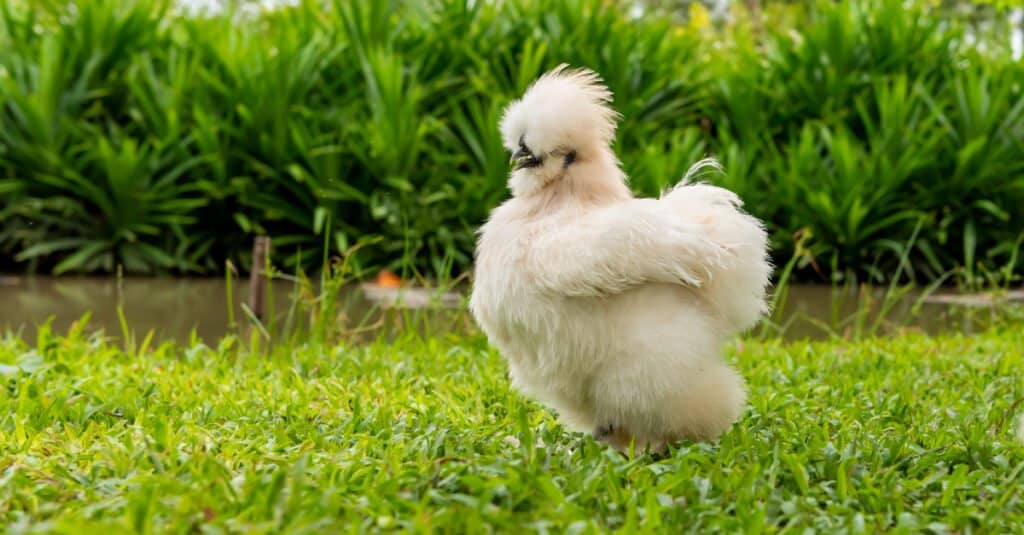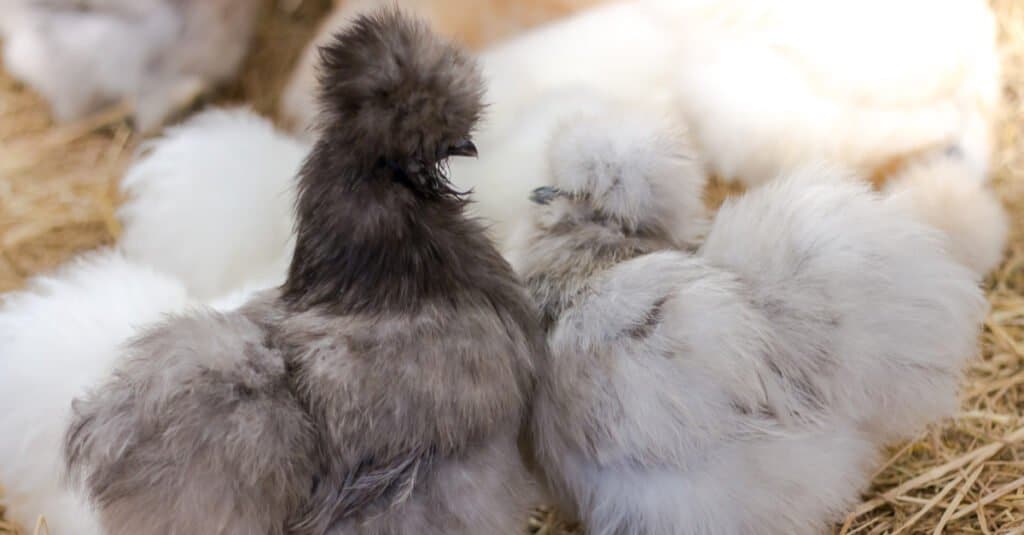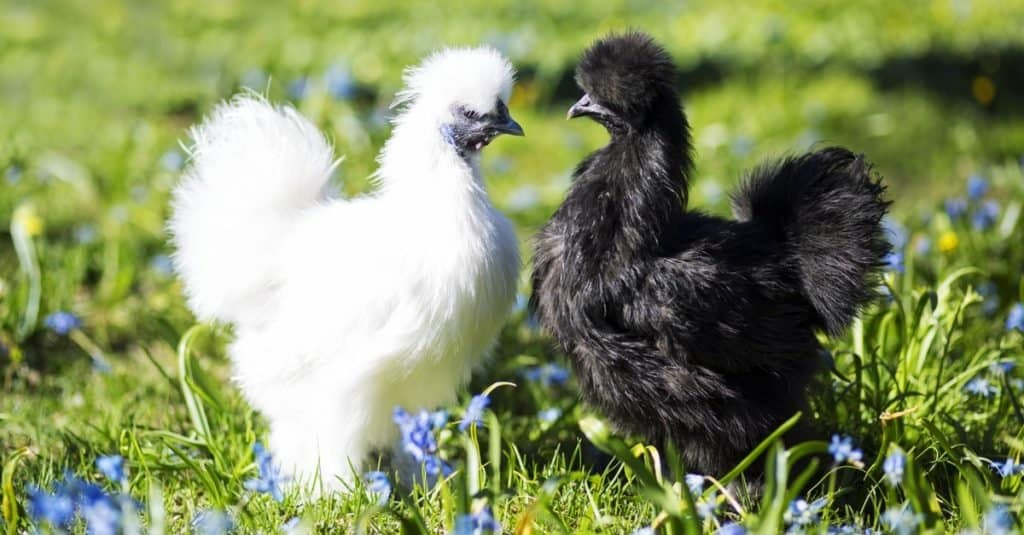Silkie chickens, also known as Chinese silk chickens, are a delightfully unique breed of fowl. Their unusual fluffy feathers and docile, affectionate personalities set them apart from other types of chickens. In fact, some people love silkies so much that they keep them as pets. Baby silkie chickens make particularly endearing additions to the family, though there are a few things you should know about them first. Read on to discover 9 fascinating facts about baby silkie chickens!
1. Baby Silkie Chickens are Born with Unique Feathers

MR. AEKALAK CHIAMCHAROEN/Shutterstock.com
From birth, baby silkie chickens look different than other chickens. This unique breed derives its name from the unusual “silky” quality of its feathers. Unlike most other chicken breeds, the silkie lacks barbicels on its feathers. Barbicels are the hooks that hold feathers together and give them their typical stiff look and feel. With feathers that look and act more like down, baby silkies never gain the capacity to fly.
Without barbicels, silkies are also more prone to wetness and cold. They have very little natural insulation and must be kept warm and dry at all times. Baby silkies are especially vulnerable to hypothermia.
2. It’s Difficult to Tell the Sex of Baby Silkie Chickens
Silkie chicks are difficult to sex due to their long maturation process. Before the age of three months, it’s next to impossible to tell the difference between most males and females. Late bloomers may not show adequate signs until the age of six months.
Once they do mature, there are a few ways to identify silkie chickens as male or female. The first indicator is size. Roosters tend to be significantly larger than hens in adulthood. They also crow, unlike hens, though this likely won’t start until the age of six months.
Another indicator has to do with feathering. Though both hens and roosters have saddle feathers (feathers along the back and tail), these are longer and pointier in males. Likewise, roosters have streamers (long, thin feathers) coming out of their crowns, which are oval-shaped. In hens, the crown is neat and rounded.
Finally, roosters have more prominent combs and wattles and exhibit more aggressive behavior. Eventually, they will begin pecking hens’ heads and backs to indicate sexual interest. Their posture is more upright than that of hens, who tend to lean over.
3. Silkie Chicks Produce a Lot of Dander

One of the drawbacks to raising silkie chicks is the dander. Due to the unusual quality of their down-like feathers, silkies produce a lot of dander and dust, especially as chicks. Breeders with allergies may find this a problem. Likewise, those intending to keep silkie chicks as pets should be prepared for a copious amount of dust in their homes.
4. Silkie Chicks May Have to Share Their Mother
Silkie chicks may not be the only young in their mother’s nest. These hens make excellent mothers and hatchers. In fact, enthusiasts know them as the breed that can “hatch a rock.” Broody in temperament, silkie chickens are usually willing to sit on eggs from other chickens or even other species, like ducks and geese. For this reason, some breeders purchase silkie hens for the express purpose of hatching other chickens’ eggs.
Ironically, despite their natural mothering temperament, silkies aren’t great layers. They lay a maximum of three to four eggs a week, rarely exceeding 120 to 150 eggs per year. The eggshells are creamy in color and safe to eat.
5. Silkie Chicks are Born with an Extra Toe

9wittgiggs/Shutterstock.com
Most chicken breeds have four toes, three in the front and one in the back. Silkie chickens, however, differ in this regard. Silkies are born with an extra toe, bringing their total number of toes to 10. Occasionally, a silkie chick may be born with even more! Two of their toes are feathered, which is another unusual adaptation for this breed.
6. Silkie Chicks Cost as Little as $3
It might surprise some people to know that they can buy a baby silkie chicken for as little as $3. Depending on the breeder and the chick’s age, a chick may cost up to $10. Adult silkie hens and roosters cost a little more, typically between $15 and $50. Again, the quality of the breeder makes a big difference when it comes to the price tag.
Experts advise first-time chicken owners to purchase week-old chicks instead of day-old chicks. Older chicks require less care and expertise and are much less likely to die.
7. Baby Silkie Chickens are Great Jumpers
Because silkie chickens can’t fly, the assumption may be that they can’t escape their enclosures. However, experienced silkie owners know that even little chicks can get out of their brooders (heated enclosures for young chicks) if the walls aren’t high enough. Silkie chickens are great jumpers and may use their skills to escape and wander free. Unfortunately, this means more exposure to the elements and to predators.
The walls of a brooder should be at least 12 inches high for chicks up to three weeks of age. For chicks older than this or with a particular bent for escaping, 24-inch walls are the best bet.
8. Baby Silkie Chickens are Affectionate and Cuddly

Einar Muoni/Shutterstock.com
Although most people don’t think of chickens when they think of their favorite pet, silkie chickens are renowned as the “lap dogs of the chicken world.” With affectionate temperaments and a high tolerance for petting and cuddling, they make lovable companions right from day one. For this reason, many people keep silkies not as farm animals but rather as household pets.
Silkies are also generally easy to care for, making them a good beginner pet. With the right conditioning as chicks, they should grow accustomed to handling and petting.
9. Silkie Chickens Encourage Their Chicks to Eat
Silkie chickens often encourage their chicks to eat by engaging in “tidbitting.” This behavior involves picking up bits of food and dropping them again, then calling the chicks over to taste it. Hens most frequently engage in tidbitting with chicks, though some have observed silkie roosters doing the same.
If you’re looking for a prolific layer, the silkie chicken probably isn’t right for you. However, if you’re looking for a terrific brooder or an affectionate pet, a silkie chick or two might be just what you need.
Up Next:
The post Baby Silkie Chicken appeared first on AZ Animals.
from Animal News, Facts, Rankings, and More! - AZ Animals https://ift.tt/65oyLvi